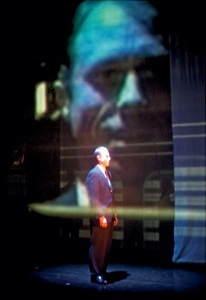NATURALISM AND SYMBOLISM:
EARLY MODERNIST PRACTICE
Interior of the Théâtre Libre in its original home in the Passage de l'Élysée des Beaux-Arts (probably)
Rebellato, Dan. 'Naturalism and Symbolism: Early Modernist Practice.' In Routledge Drama Anthology and Sourcebook: From Modernism to Contemporary Performance, edited by Maggie Gale and John Deeney, 6-24. Abingdon: Routledge, 2010.
My contribution to The Routledge Drama Anthology and Sourcebook: From Modernism to Contemporary Performance edited by Maggie Gale and John Deeney is an introduction to Naturalist and Symbolist theatre in the 1880 and 1890s. It's intended as an introduction to students, but draws on a lot of original research and thinking.
One of the aims is to restore the sense of Naturalism as an avant-garde, experimental theatre movement, with a particular view of the world, rather than merely a naive desire to represent the world realistically. A key thought in the essay is that Naturalist theatre manifests itself in two strands: a 'sociological imagination' and a certain 'visual culture'. The former is a particular view of society, which believes that human behaviour is best understood in scientific terms, that humans are merely a kind of animal, to be understood physiologically: this view is held by the Naturalists to be distinctively Modern and the duty of an artist is to show this without fear or squeamishness. The latter is a belief that resemblance of a particularly strict and literal kind is the appropriate way of conveying this view of the world.
The essay goes on to argue that Naturalism's contradictions enrich and complicate its performances and that, time and again, the plays seem to turn against the views of their creators: Strindberg's misogyny is unpicked and anatomised in Miss Julie; Zola's desire for unmetaphorical, scientific directness only generates its own metaphors.
In the last sections, I discuss Symbolist theatre an even more contradictory enterprise, since many Symbolists were fundamentally hostile to the very idea of performance. I show how their attempts to work through this contradiction generated a very powerful series of new experimental theatrical devices, often controversial, frequently disastrous, which in some senses radically opposed Naturalism, but in some senses adopted wholesale its attitude to the audience, its model of performance, and even some of its venues.
The original version of the essay was over 18,000 words long and was cut down to under 10,000. You can read the original here.
UPDATE: I was preparing a reader for my student recently and wanted to include the Pierre Quillard essay that I translated for the original and I was dissatisfied with the translation so I’ve had another go. HERE is my revised translation.



![photo[1].jpg](https://images.squarespace-cdn.com/content/v1/513c543ce4b0abff73bc0a82/1362919072201-PZO854G4SEB794DVOEI8/photo%5B1%5D.jpg)
